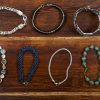Fashion Life
As I write in the cover story in this week’s TIME International, blood diamonds still exist, and the industry as a whole is still beset by problems over conflict, smuggling and child labor. Even worse, because the existing Kimberley Process certification system has so many loopholes, it can be almost impossible to be sure that your diamond isn’t tainted. But if you’re in the market for an engagement or wedding ring, there are ways to ensure that your money is more likely to help miners on the ground in countries like the Congo than it is to hurt them. Here is a checklist to make sure your lifetime investment doesn’t mean a lifetime of poverty and suffering for someone else:
Even under the best of circumstances, spending a few thousand dollars on a diamond can be a fraught decision. Add to that concerns that the diamond in question may have funded a far off conflict, contributed to human rights abuses, unfair labor practices or harmed the environment in its extraction, and the process becomes downright agonizing. Until the diamond industry can establish a transparent certification process similar to one that lets you drink your fair trade coffee with peace of mind, splashing out on a solitaire or a tennis bracelet in an ethical way requires some legwork. Your 10-step guide for the responsible consumer.
- Ask your jeweler where the diamonds were mined. A responsible jeweler will know every step in the path from mine to market. If he doesn’t, move on.
- Demand details. Don’t settle for vague assurances about reputable suppliers or Kimberly Process certification—the KP does not ban diamonds that fund war crimes and human rights abuses by government forces. Nor does it address unfair labor practices or environmental degradation brought about by irresponsible diamond mining. “Consumers need to ask questions when they shop, and to resist the easy answer,” says Ian Smillie, a conflict diamond expert and author of several books on blood diamonds, including Blood on the Stone: Greed, Corruption and War in the Global Diamond Trade
- Avoid diamonds that come from countries like Zimbabwe and Angola, where human rights abuses in and around mines have been well documented by organizations such as Amnesty International and Human Rights Watch.
- Look for diamonds mined in Canada. They may be more expensive, but labor and environmental standards are rigorously enforced. That said, buying Canadian diamonds doesn’t help African countries improve their industries. Consider donating to organizations like Diamond Development Initiative International, a group that’s working to support small-scale diamond operations around the world.
- In Africa, Namibia and Botswana are another good bet. Those countries work with small-scale miners as well as large-scale industry to make sure that income from mining creates jobs and leads to development. Both countries enforce strict labor and environmental standards. Sierra Leone is going in that direction, though the recent Ebola outbreak has temporarily set progress back.
- Know your supplier. De Beers’ Forevermark diamonds come with a guarantee that each one was mined with stringent criteria on responsible sourcing. Though you can’t trace your Forevermark diamond back to the exact mine where it came from, the company invests substantially in local communities by building schools and hospitals near its mines in Botswana and South Africa. It also funds micro-credit enterprises and mentorship programs to help communities transition from diamond-based economies to more sustainable livelihoods, in preparation for the day when the diamonds run out. Other companies like Tiffany, Signet and Cartier are investing in cutting and polishing plants in Botswana, which means more of the diamond income stays in the country.
- Buy from jewelers that make a commitment to ethical sourcing, like Hume Atelier and Brilliant Earth or Chicago’s Leber Jeweler. Not only are they doing all the hard work when it comes to asking the right questions, they are actively pushing for certification changes in the diamond industry. They also fund organizations like the Diamond Development Initiative, which is working to support small-scale miners around the world.
- Recycle. Look for vintage or antique rings. A good jeweler can reset, or even recut, an old stone to make a modern ring. They may have had bloody beginnings, but at least its over.
- Consider alternatives. Synthetic diamonds have the same sparkle, with none of the dirt. And colored gemstones, while plagued by the some of the same issues as diamonds, are much easier to trace. Columbia Gem House and Nineteen48 are a good place to start.*Don’t stop with the diamonds. Check the origin of your gold as well. Gold mining leaves toxic wastes like mercury and cyanide that are very damaging for the environment and the people who mine it. It also funds conflict. Opt for recycled gold, or Fair trade gold.













































Leave a reply